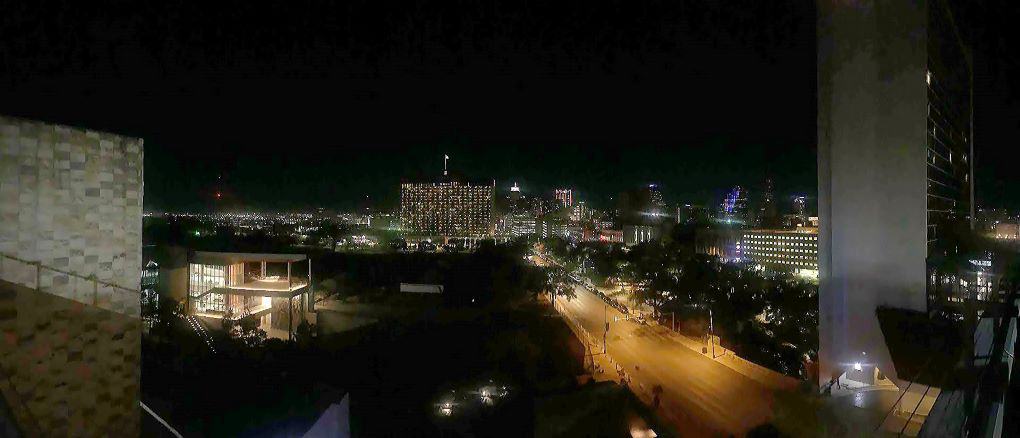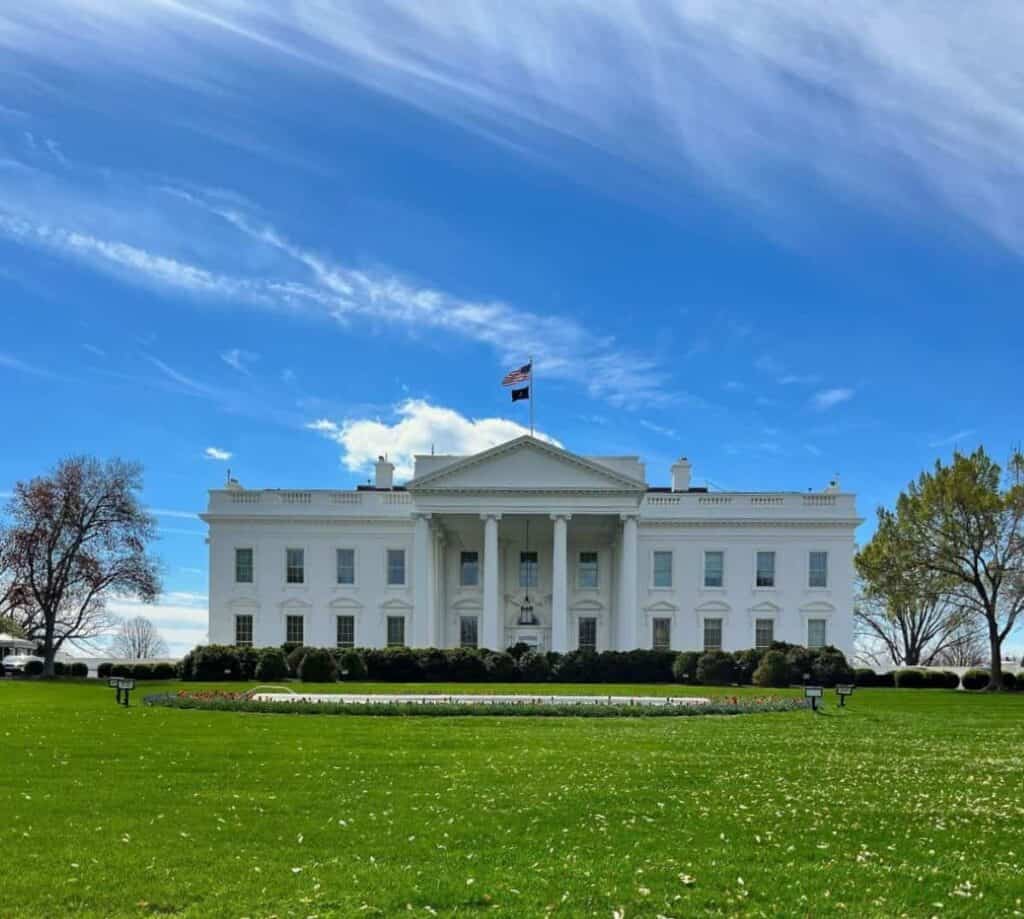On a recent long weekend, I was excited to finally explore the Fort De Soto National Memorial. This memorial celebrates the landing of Spanish explorer Hernando de Soto and his men in Tampa Bay on May 30, 1539. De Soto arrived in La Florida. It was an arduous journey, seeking glory and riches in the new world.
Hernando de Soto sailed to La Florida from Cuba on nine ships with 700 men, women and children, 220 horses, war dogs, and a herd of pigs. This was the first major Spanish foray of what is now the southern United States.
This post may contain affiliate links, meaning if you purchase something through one of these links, we may earn a small commission at no extra cost to you! Read the full disclosure policy here.

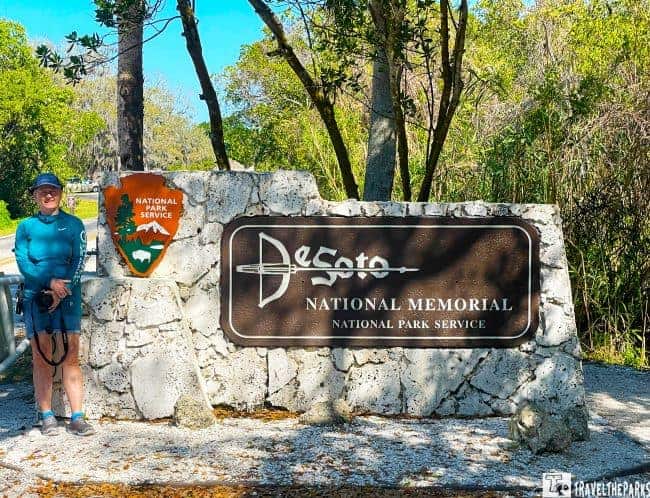
Table of Contents
De Soto National Memorial Guide
The National Park Service administers the DeSoto National Memorial and is open to the public throughout the year. De Soto National Memorial was authorized by Congress on March 11, 1948 and listed on the National Register of Historic Places on October 15, 1966. It covers less than 30 acres.
The memorial includes a visitors’ center, a theater, and a 1-mile nature trail. The trail that leads to the beach where the original landing took place. There are also informational kiosks showcasing the history of the native peoples found by DeSoto. The Living History Camp program is offered at various times throughout the year, and they encourage visitors to check the park’s website or contact the visitor center for more information on upcoming living history events.

Directions to the DeSoto National Memorial
DeSoto National Memorial sits along the shores of Tampa Bay in Bradenton, Florida. An easy day trip from Orlando, Tampa or Everglades.
Orlando/Tampa: I-4 west to I-75 south. Take exit 220, follow SR 64 (Manatee Ave) west 12 miles, passing through downtown Bradenton, to reach 75th St W. Turn right and continue 2 miles to the parking area.
Naples/Everglades: I-75 North. Take exit 220, follow SR 64 (Manatee Ave) west 12 miles, passing through downtown Bradenton, to reach 75th St W. Turn right and continue 2 miles to the parking area.
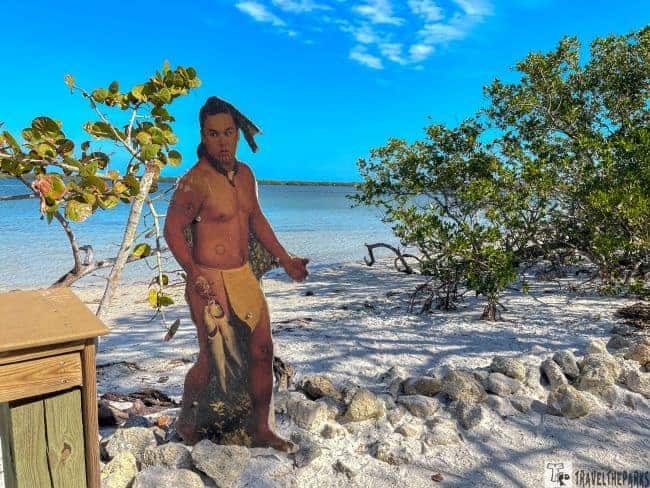
Hernando DeSoto the Conquistador’s Expedition in the New World
Hernando de Soto was a Spanish explorer who lived from around 1496 to 1542. After landing at Tampa Bay, he sought to find gold and riches. The expedition traveled north, exploring parts of Georgia, South Carolina, and North Carolina, before turning west into what is now Tennessee and Alabama. The expedition trekked 4,000 miles during the 4-year journey. The explorers then traveled south through Mississippi and Arkansas, and crossed the Mississippi River into what is now Louisiana. De Soto died of a fever near the Mississippi River in 1542. It is believed he died from an infection, perhaps from an indigenous Chickasaw arrow that pierced his leg. Shortly thereafter, his men abandoned the expedition.
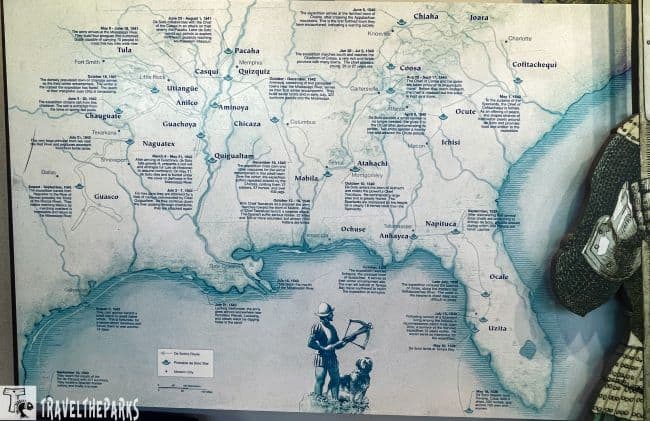
Although the expedition did not find the riches that De Soto had hoped for, it provided the first extensive exploration of the southeastern United States by Europeans, and opened the way for further exploration and settlement of the region.
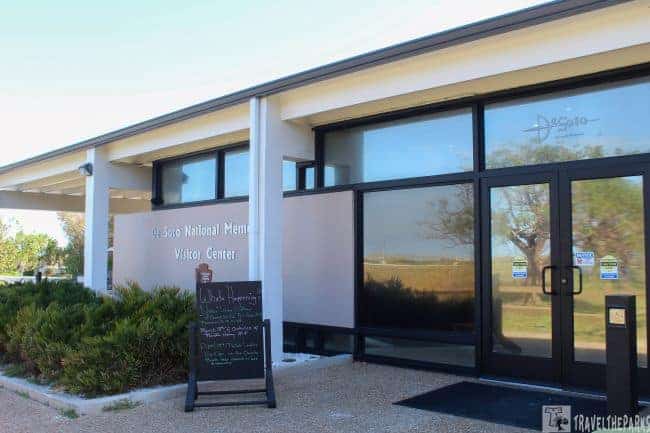
Things to do at De Soto National Memorial: Start at the Visitor’s Center
The visitor center is the starting point for exploring the park and learning about the history and culture of the region and the indigenous “Tocobaga” people. The DeSoto National Memorial Visitor Center can be found northeast of the parking lot and is open seven days a week from 9:00am to 5:00pm. It is closed for Thanksgiving, Christmas, and New Year’s Day, and there is no admission fee to enter. The park is a popular destination for history buffs, nature lovers, and anyone interested in learning about the rich history and cultural heritage of the region.
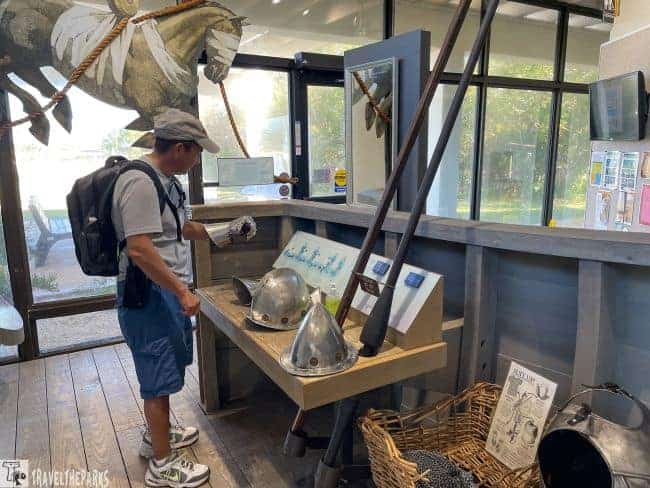
We stopped at the information desk to get our passport stamp before looking over the front exhibits. The volunteer explained how visitors can also take part in ranger-led talks, walks, and activities. The De Soto landing event held each year in March is a popular reenactment of the beach landing of the DeSoto party.

What to see at De Soto National Memorial Indoor Exhibits: Learn History
Inside features exhibits, displays, and educational programs that summarize the park’s history, as well as the area’s history and culture of the “Tocobaga” tribes that lived in the area before DeSoto’s arrival. Checking out the museum, we read about the facts on Hernando de Soto’s expedition across the southern U.S. We also took the time to view a short 22-minute film, “Hernando de Soto in America.”
The film is insightful as the De Soto expedition was not without controversy. The Spaniards introduced several fatal diseases to the indigenous people. Also, in terms of environmental impact, domestication of pigs had the longest lasting effects.

The Indigenous “Tocobaga” People
The Tocobaga were an indigenous people who inhabited the Tampa Bay area, from the 14th to the 16th century. They were one of several groups of Native Americans who lived in the region prior to the arrival of Europeans.
Their subsistence relied heavily on the resources of Tampa Bay and their skills as anglers and hunters. They used nets and spears to catch fish and other aquatic animals, and they hunted deer, rabbits, and other small game.
A large chiefdom dominated their complex society. The chief maintained order and settled disputes among the people. The Tocobaga also had a complex religious system, which included the worship of several deities and the use of ceremonial mounds for religious ceremonies.
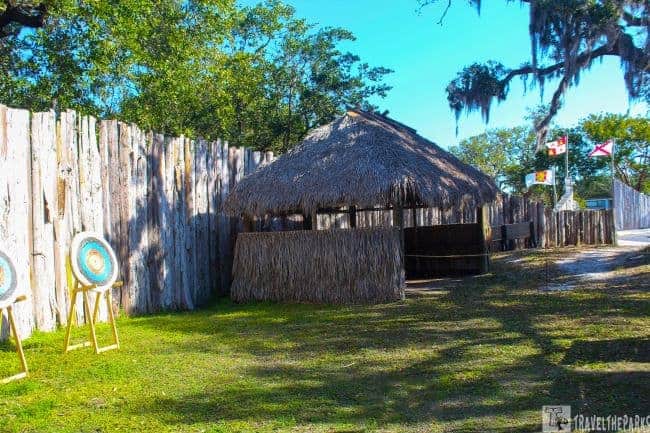
Self-Guided Walk of the Grounds
Next to the parking area, there is a large picnic area, perfect for a snack or lunch break. Bottle refill stations are at the back entrance of the visitor’s center. On warm, humid days, wear long sleeves with long pants to protect against the mosquitoes and ticks. Bug spray or clothing containing 0.5% permethrin can repel ticks.
We wandered the grounds and viewed the artifacts on display before heading over to Camp Uzita to watch the first living history presentation of the day. The early morning breeze off the bay kept the bugs to a minimum.
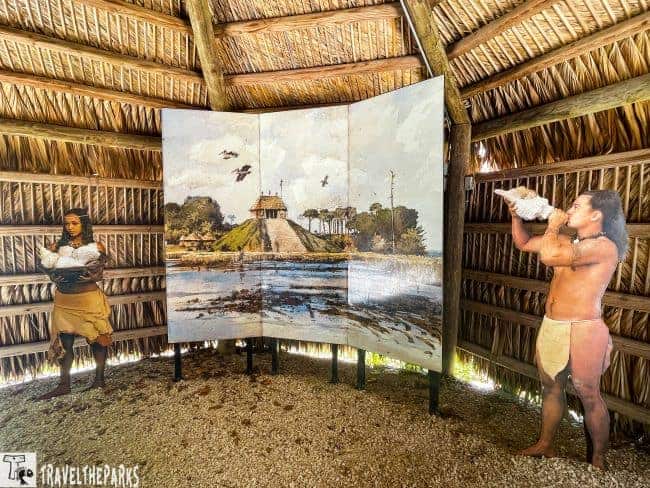
Replica Charnel house
There is a replica of traditional indigenous native charnel or temple house. In the southeastern United States, Charnel houses (much like chickee huts) are traditional Native American structures that are built with a thatched roof made from palmetto fronds or other natural materials. Wood or bamboo poles usually support the roof.
Charnel houses are buildings or structures used for the storage and disposal of human or animal bones or corpses. They provided protection from the sun and rain while allowing for ventilation and air circulation, which was important in the hot and humid climate of Florida. Large panoramic paintings inside detail how they would have lived and used the charnel temple houses.
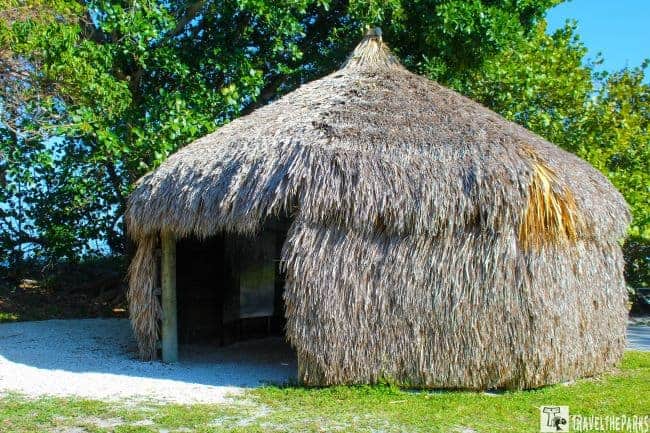
In front of the visitor’s center, you see a large granite monument. The National Society of the Colonial Dames of America dedicated the monument during the 400th anniversary commemorating the 1539 landfall of De Soto’s expedition. The monument also marks the beginning of the De Soto Trail. It is a 34 stop Florida driving tour of locations connected to the De Soto’s expedition.
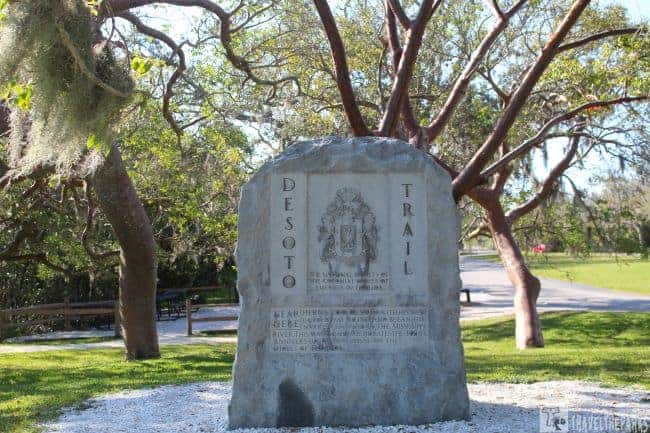
View a Living History Reenacted at Camp Uzita
Don’t miss the park’s best feature of this memorial the living history at Camp Uzita. They named it after one of the chiefdom leaders of the “Tocobaga” that they met upon arrival. The living history program offers visitors a unique opportunity to step back in time and experience the daily life of DeSoto’s expedition. The village is based on De Soto’s first base camp in Florida, the replica village is small in scale. The Living History Camp demonstrations are open December through April.
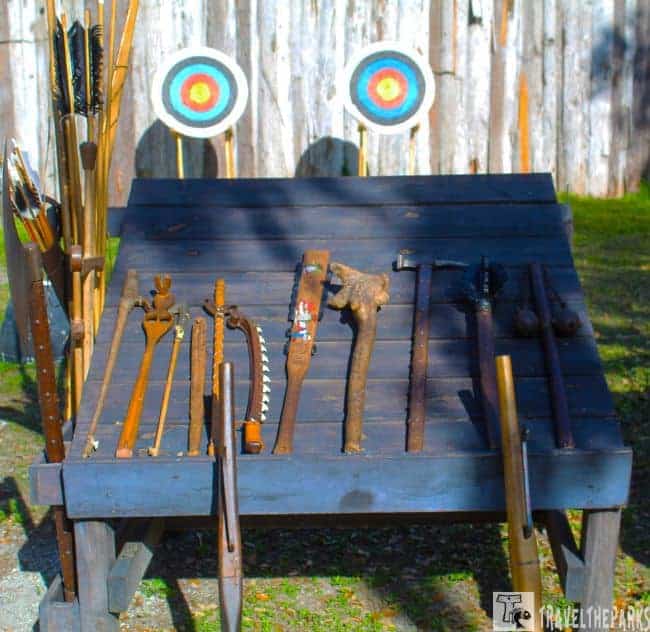
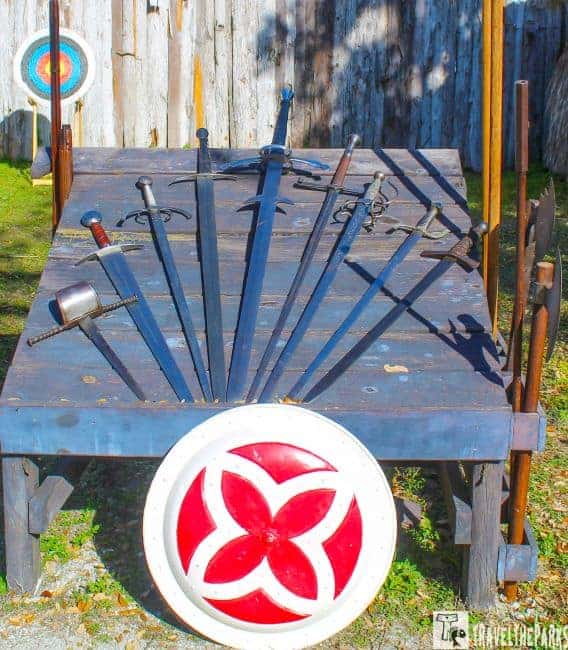
Volunteer re-enactors who dress in period clothing and use historical tools, weapons, and equipment to recreate the Spanish camp staff the living history camp. Visitors can watch demonstrations of Spanish military drills, cooking, blacksmithing, and other activities, and can interact with the re-enactors to learn about the challenges and triumphs of life on the expedition.

The park staff designed the living history program at the DeSoto National Memorial to provide an educational and immersive experience that helps visitors understand the history and culture of the 16th-century Spanish exploration of Florida. Listen to the matchlock arquebus and learn how it, along with other weapons, helped shape American history for 500 years.
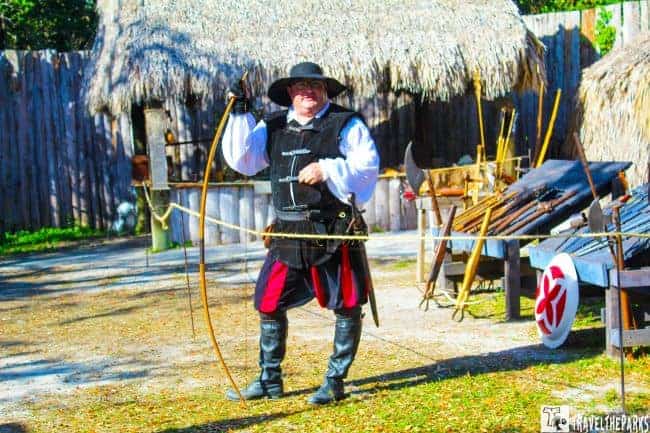
Watch a Demonstration of the Firing of the Arquebus
Interesting way to learn about the arquebus (also spelled arquebuse) by the firing demonstration. It is an early type of firearm dating back to the 15th century. The re-enactor explained it was a long gun with a matchlock mechanism, which used a slow-burning wick to ignite the gunpowder in the barrel. He showed the firing of the weapon. Due to its weight, it was difficult to fire accurately from the hand, so they used rests or shoulder stocks.
He told us the arquebus was deadly accurate for about 30 yards. However, it was not at all accurate for long-range shooting. As a result, you were more likely to shoot bystander rather than your intended target. The arquebus was very slow to load and fire. The noise alone produced the fear that traditional weapons could not get, such as bows and crossbows.
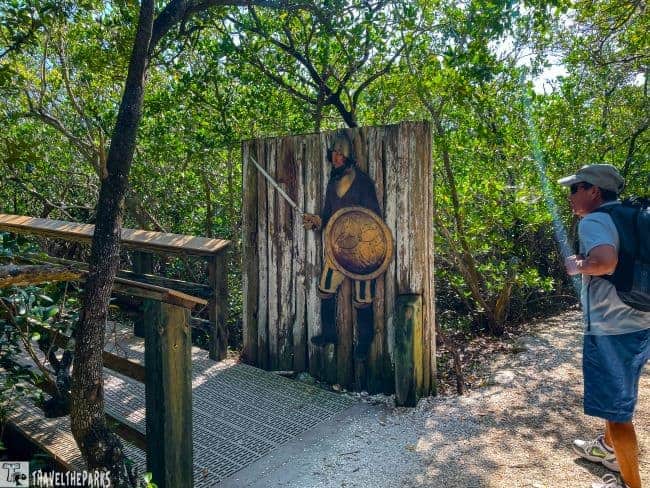
Walk the De Soto Memorial Nature Trail
The trails of De Soto National Memorial are accessible from sunrise to sunset every day. The main entrance and parking lot are open daily from 8:00 am to 5:00 pm. The nature trail at DeSoto National Memorial is a one-mile walking trail. It winds through the park’s natural environment, providing visitors with an opportunity to explore the local flora and fauna. The wide shell path begins at the visitors’ center. As we walked, we considered what it would have been like almost 500 years ago when DeSoto landed. The mosquitoes and biting insects must have been terrible.
Depending on the time of the year, I recommend wearing comfortable shoes, sunscreen, bug spray, a hat, sunglasses and plenty of water.

Visitors can see a variety of trees and plants, such as live oaks, sabal palms, and saw palmettos. There are also opportunities to observe wildlife, such as wading birds, ospreys, and other shorebirds. We began the trail at the visitor center. Following the boardwalk, it leads to the shoreline of Tampa Bay. Here is where you can see the original location where Hernando de Soto and his army landed in 1539.
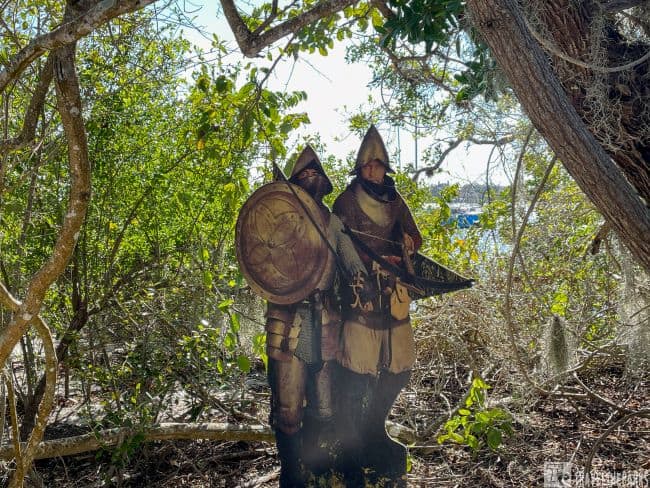
Elevated Boardwalk-Mangrove Trees
Overlooking the coastal hammock, characterized by mangroves adapted to survive salt spray and strong winds, is a wooden boardwalk. The park is 80% intertidal mangrove and the elevated boardwalk is an ideal way to appreciate this habitat. We could see the complex network of roots and branches of mangrove trees, which serves as a nursery for many species of fish and crustaceans.
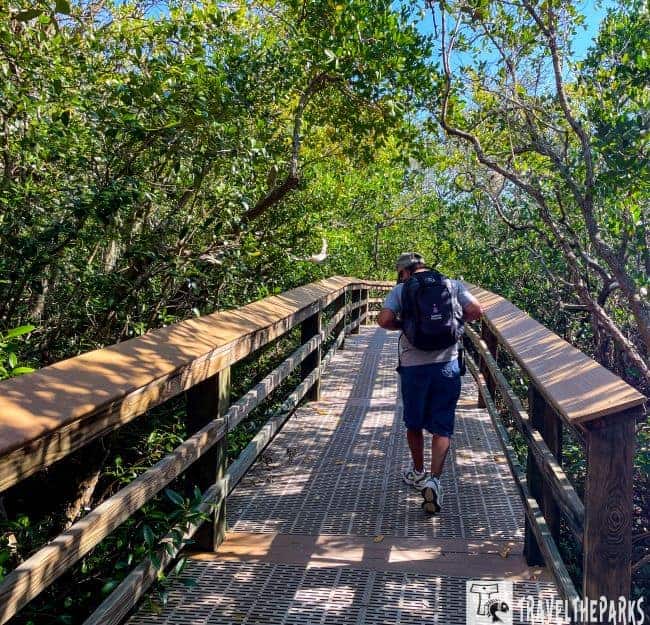
Mangrove estuaries also provide important ecosystem services, such as stabilizing coastal soils, protecting coastlines from erosion and storm damage, and filtering pollutants from runoff. They are also important carbon sinks, meaning that they store large amounts of carbon dioxide, which helps to mitigate the effects of climate change.

The trail is well-marked and is good for visitors of all ages and capabilities. We highly recommend wear comfortable shoes, bringing insect repellent, as mosquitoes and other insects are prevalent. If you have time, ranger-led tours provide additional information on the natural history of the area and the DeSoto expedition.
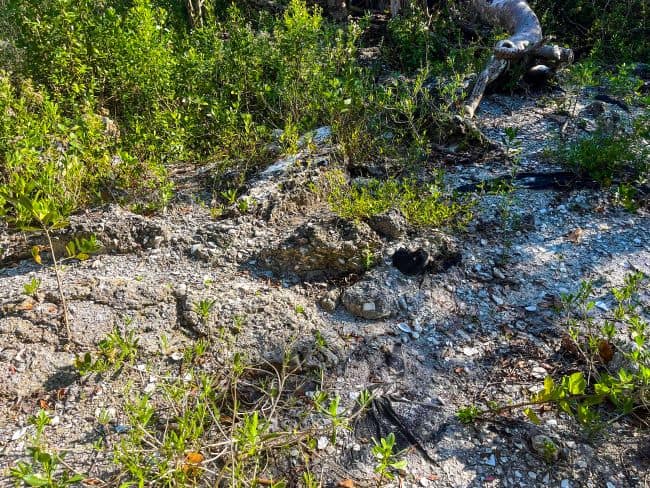
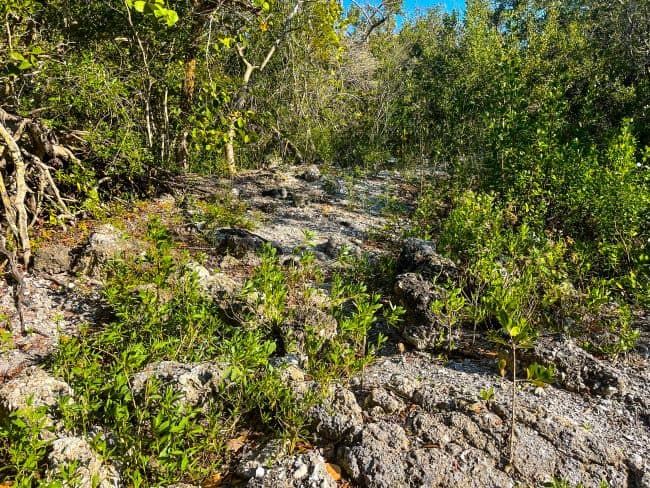
Detour Spur Trail to the Tabby House Ruins
Venturing off the trail is a short spur trail that will take you to the Tabby ruins. In the late 1700s, this site (Shaw’s Point) was a Spanish fishing camp, according to recent archaeological investigations. However, even though the origins of the tabby ruins here are unknown, it is believed that William H. Shaw and his family built on this site within months of his settlement in 1843. The family lived and worked here until the Seminole Indians revolted in 1856, drove them to Key West.
Tabby is a type of building material that was commonly used in the southeastern United States, particularly in coastal regions, during the 18th and 19th centuries. It is a mixture of lime, sand, water, and oyster shells, and they often used it as a cheap alternative to brick or stone.
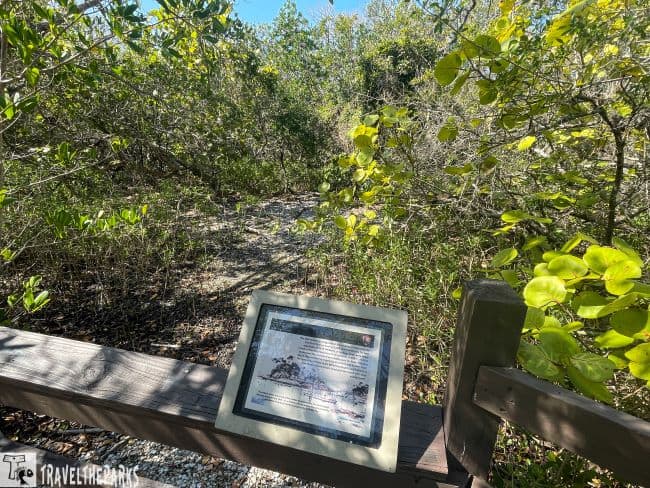
Shell Midden-Hidden Evidence
This shell midden is a remnant of the Native Americans that lived here many hundreds of years ago. Shell middens are significant archaeological sites that provide insights into the diet, lifestyle, and culture of past human populations. The shells found in these middens are often from edible shellfish such as clams, oysters, and mussels, and may also contain bones and other artifacts such as stone tools and pottery. They were essentially a garbage pile.
One of the most important features of midden places is that archeologists can easily date the shell using the radiocarbon method of dating. The park has identified 11 shell middens, the oldest here dates to 365 BC.
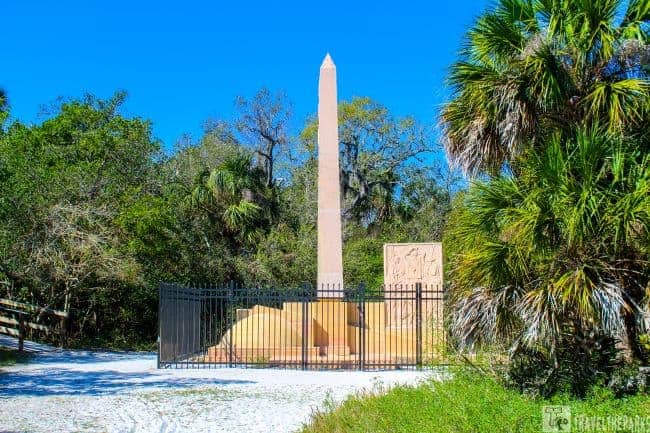
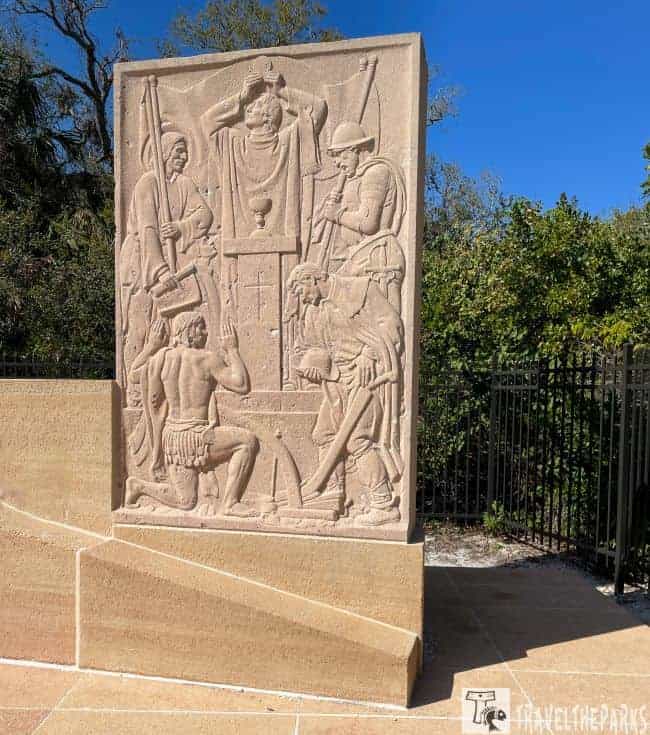
The Holy Eucharist Monument
The Hernando de Soto Catholic Memorial, also known as the Holy Eucharist Monument. As part of his expedition, De Soto reportedly celebrated the Holy Eucharist, a Christian sacrament. Quarrying and cutting the base stone took place in Mankato, Minnesota, and the carving took place in Madrid, Spain. They originally exhibited it at the World’s Fair in New York in 1969 before finding a home in the park in the late1960s.
Originally, Enrique Perez Comendador cast and sculpted a nine-foot bronze statue of Hernando de Soto. Today they house in the South Florida Museum and Bishop Planetarium after someone vandalized it on the memorial grounds.
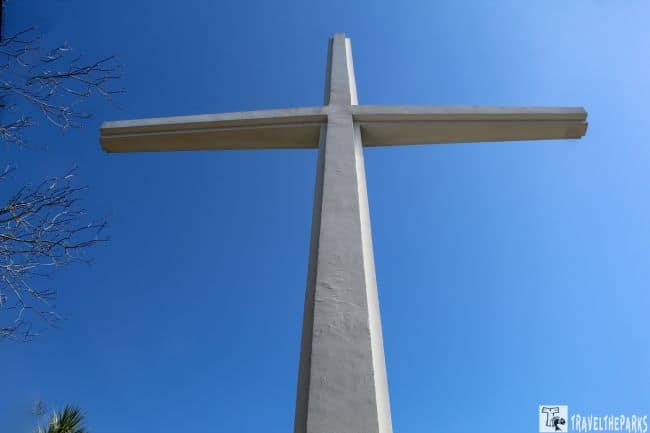

The Catholic Diocese of Venice in Florida erected the Memorial Cross here in 1995. It is dedicated to all the priests serving in Florida, beginning with the twelve priests and friars who accompanied the 1539 De Soto expedition. Together, the Holy Eucharist Monument and Memorial Cross serve as important historical and cultural landmarks within the De Soto National Memorial. They help to commemorate the exploration and colonization of the region by European explorers and serve as reminders of the complex history of the United States.

Final Thoughts Exploring De Soto National Memorial A New World
Overall, the living history program at the DeSoto National Memorial is a popular and engaging way to learn about the rich history and cultural heritage of the region, and to experience firsthand the challenges and adventures of life on a 16th-century Spanish expedition. This is definitely worth adding to your itinerary if you are in the Bradenton area. Consider adding day trips to Egmont Key or Robinson Preserve.
Have you visited this memorial? What did you think? Please share your comment below, we would love to know.


